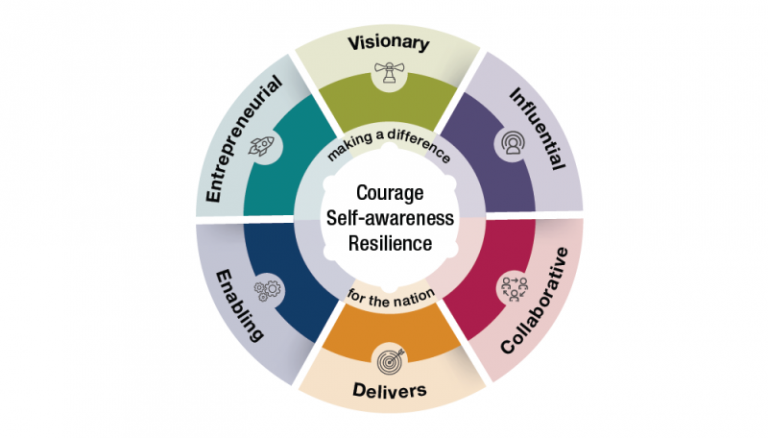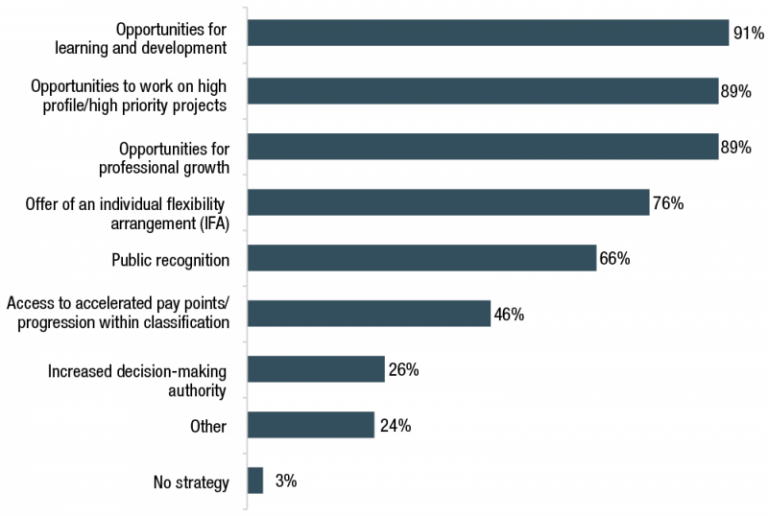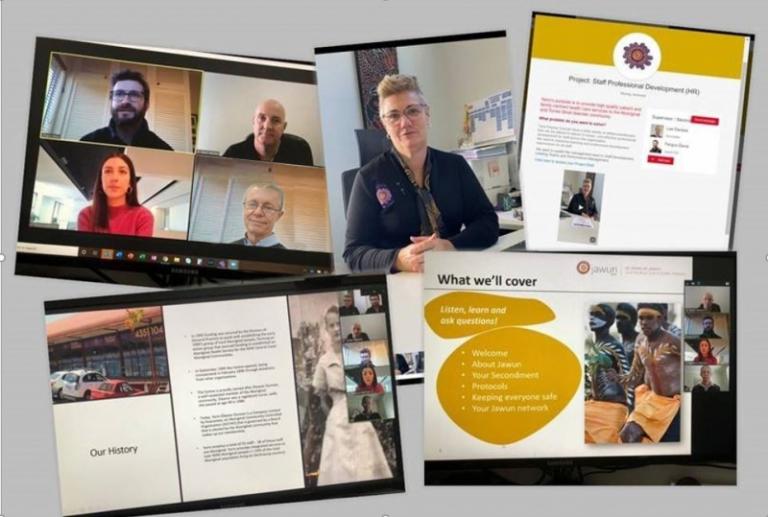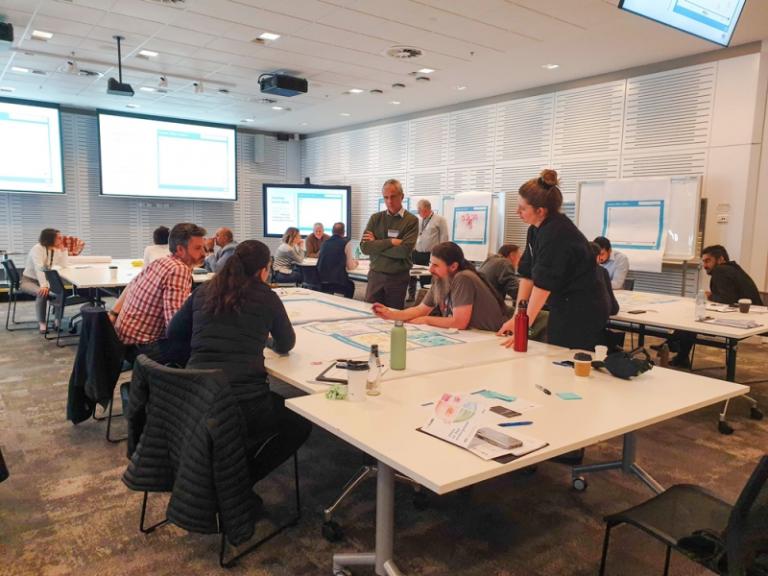Effective workforce management
A whole-of-service workforce strategy will provide the overarching framework for building and sustaining the way the APS attracts and develops its people, and utilises their talent.
The first of its kind for the APS, it will build on efforts to strengthen critical capabilities through professional streams, drive workforce productivity with a high performance culture, and develop a strong pipeline of APS leaders.
Leadership
‘Public service leadership has never been so challenging or complex. Public service leaders work across organisational boundaries, sectors and jurisdictions to tackle ongoing and emergent policy challenges and improve the impact of public services. They have to make space for innovation while managing risk and being accountable for results…The coronavirus has shaken up many old assumptions of public service working methods…Effective public service leaders rose to the challenge, leveraging new technologies and managing their workforces in new ways to protect their wellbeing while maintaining and boosting the delivery of essential services.’
- OECD[104]
The COVID-19 pandemic has demonstrated the critical nature of collaborative and networked leadership for managing complex challenges. In times of crisis, leadership must be people-focused, calm, credible and trusted.[105]
The results of recent internal APS agency employee surveys reflect positively on the APS leadership cohort. During the initial pandemic response, available data indicates that employees felt supported by their managers, empowered and trusted. For example, the vast majority of respondents from one agency (93%) reported that their managers trusted them to work productively while working remotely.[106]
Leaders have surfaced relevant skills and expertise in areas that proved critical to the pandemic response, and engaged with risk to accelerate delivery.
Developing leaders
Within the public sector, building leadership capability centred on improving outcomes for society is considered a fundamental condition for trust in public institutions and governance.[107]
In the APS, the SES are expected to ‘provide APS-wide strategic leadership of the highest quality that contributes to an effective and cohesive APS.’[108] The SES must promote cooperation within and between agencies and provide professional or specialist expertise, policy advice, program or service deliver and/or regulatory administration at a high level.[109]
In 2019, as part of the APS reform agenda, it was agreed that all SES employees would take part in a capability assessment process to help target development and guide career paths. To date, 251 SES (72 SES Band 3 employees, 179 Band 1 and 2s) have been assessed against the APS leadership capabilities established in 2017.
The assessments were paused temporarily during the pandemic response, however over time will provide the APS with oversight of the experience, skills, capability of the APS leadership cohort, including strengths and capability gaps.
Figure 2.2: APS Leadership capabilities and personal qualities

SES capability assessments to date identify areas of strengths in ‘delivering results’, ‘collaboration’ and ‘influence’. However, there is room to develop these capabilities further to fulfil stewardship responsibilities and have greater impact across the APS enterprise.
Assessments indicate that the capabilities requiring development for the current cohort are ‘visionary’, ‘enabling’ and ‘entrepreneurial’. These are key to shaping long-term organisational strategy, developing high-performing teams, and harnessing the benefits of diverse thinking and perspectives to explore new possibilities. As the APS contends with increasingly complex public policy challenges and ambiguity these capabilities are becoming more critical.
Leadership attributes such as courage (engaging with risk and making difficult decisions), self-awareness (being open to feedback and understanding own strengths, weaknesses and impact on others), and resilience (being adaptable and remaining positive and forward-thinking despite challenges) are essential. Of these, results indicate there are higher levels of resilience and courage with room for greater self-awareness.
The results of SES capability assessments inform individual development plans and intensive leadership programs. These focus on developing adaptive capabilities that senior leaders need now and in the future: influence, working with and through others, engagement and collaboration skills, and experimentation and risk-taking. These themes extend into general leadership programs available to all SES and EL 2s across the APS, with a strong focus on improving self-awareness and confidence as a leader.
SES leadership capability framework
The APSC is now extending the SES leadership capability framework—initially developed for talent assessments—for broader application in recruitment, performance management, development and mobility to ensure leadership capabilities are suitable for the future.
Drawing on the Integrated Leadership System and Work Level Standards, the extended framework will articulate skills, knowledge and attributes which underpin the current model of SES capabilities and identify behavioural indicators for each SES classification.
High performance
A high-performance culture promotes and incentivises effective performance and fosters talent. It has clear performance expectations, focuses on performance improvement, and actively manages performance issues. It requires mutual accountability for achieving effective performance.
Positive culture cannot simply cascade down. Everyone involved needs to live and breathe its values.
Effective performance management must hold both leaders and individual employees accountable for their performance, and must be consistently applied across the service. To reinforce this shift, the APS Commissioner’s Directions were updated in 2019 to clarify the obligations of Agency Heads, supervisors, and APS employees in achieving, promoting, and fostering a high-performance culture.[110]
The APSC also released a guide to support agencies to adopt performance management practices at all levels of their organisations that contribute to a high-performance APS culture. This includes rewarding and recognising talent, and managing underperformance when required.[111]
Supporting high performers
One year after the Directions were amended, the APSC sought feedback from agencies to understand how they influenced changes to nurture talent and support a high performance culture. The APSC received 43 responses from a cross-section of agencies with different sizes and functions. Responses indicate 53% of agencies have updated their performance frameworks following the release of the Directions, including changes that focus on employee development and capability uplift, and that ensure high performance culture is the responsibility of all APS employees. Agencies who did not make changes noted their existing performance frameworks currently align with the intent of the Directions, or they are currently undertaking reviews to identify if future changes are needed.
Case study: High performance at Home Affairs

Caption: Nick Kirby (left) and Ryan Idder (right) from the Department of Home Affairs view the Driving a High-performing Culture Framework
‘High performance is a commitment to continuous improvement, delivering outcomes and implementing priorities on time and to a high standard. It is being reliable and trusted to provide services for stakeholders in an efficient and effective manner.’ Department of Home Affairs – Driving a High-performing Culture
Faced with an increasingly volatile operating environment, the Department of Home Affairs transformed its approach to work by developing a strategy that will help their employees prepare for the future. The Driving a High-performing Culture Framework seeks to support and embed the transformation, as well as foster and promote a high-performing culture.
It defines an inclusive approach to high performance that is relevant to all employees, regardless of level or role, and provides detailed guidance on how to meet current and future challenges as both individuals and leaders. It’s founded on the principle that high performance begins with an individual, and when individuals combine to achieve high performance as a team, they collectively contribute to the high performance of the organisation.
Building a high-performing culture requires focus on enabling, supporting and developing an organisation’s people. Underpinning the Framework are the ‘Pillars of High Performance’ which were developed from research on high performance and culture, and the factors that motivate people at work such as inspiring a sense of purpose, feeling valued and having autonomy. The pillars are:
- Leadership, Talent and Performance
- Health, Wellbeing and Diversity
- Capability, Development and Career
Each pillar details the expectations of everyone in building a high-performing culture and lists which initiatives, mechanisms and networks Home Affairs provides that foster and promote a high-performing culture. The Framework also contains practical guidance for employees and managers on how to assess the performance culture of teams. This assists and encourages individual and collective improvements, and identifies areas for development.
Since its launch in July 2020, the Framework has been embedded in the Home Affairs performance management cycle and relevant eLearning products, and will support Home Affairs’ efforts in supporting the APS reform agenda.
Under the Commissioner’s Directions, Agency Heads are required to proactively identify, foster and develop APS employees to fulfil their potential for their agency.[112] In 2020, almost all agencies had strategies in place to support and extend high performers (Figure 2.3).
Figure 2.3: Strategies employed by APS agencies to support and extend high performers

Source: 2020 APS Agency Survey[113]
Learning anywhere, anytime
While the crises of 2019-2020 have been disruptive and demanding for many agencies, continuous learning in the APS remains a key principle of workforce planning and developing a high-performing workforce.
Activities in learning and development did not pause; rather it meant agencies adopted different approaches, with a focus on 3 priority areas:
- Rapid development of training to support the deployment of people to areas of critical need.
- Supporting the ongoing capability needs of APS organisations, and partnering with industry and academia to maintain service provision agreements.
- Enabling APS employees to remain productive, engaged and connected through meaningful learning and development activities.
APS agencies looked to digital technologies to provide a blended delivery of continuous learning:
- Face-to-face classroom training and other forms of interactive learning such as coaching are being delivered by virtual delivery platforms.
- Agency Learning Management Systems (LMS) have provided their employees with access to a range of eLearning resources.
- Employees have undertaken self-directed learning activities, such as reading and research by accessing relevant online content from a range of sources.
The APSC Centre for Leadership and Learning has partnered with APS agencies and other organisations to provide access to online learning for all APS employees, complementing the learning resources provided by agencies. The APSLEARN Online Learning Catalogue makes available a mix of facilitated and self‑directed options, with topics covering core skills, public sector governance, management skills, and leadership.
These experiences also demonstrate an opportunity for further expansion beyond traditional approaches to learning and development in the APS. There is scope for self-directed learning experiences (access anywhere, anytime), common learning and professionalisation resources and platforms that are informed by a comprehensive understanding of workforce skills and needs. Agencies are continuing to collaborate to develop a personalised, social and ‘in-workflow’ learning experience across the APS.
Some elements of learning need social interaction. APSC evaluation data indicates participants value the virtual learning and are demonstrating strong increases in capability development comparable to face-to-face delivered programs. Over time an appropriate balance between online and face-to-face learning will emerge.
Before the COVID-19 pandemic, geographic location and time pressures were an obstacle to uptake of some courses. The adoption of digital technologies, including self-guided courses, has increased access to more employees, opening up possibilities for those overseas or outside major cities, or with flexible arrangements, to learn at a time that suits them.
Case study: Jawun secondment going virtual

Caption: Photos from Lee’s secondment (Lee is in the bottom right of the top left image)
‘My motivation in becoming a Jawun Secondee, was all about giving back and making a difference to community. Whilst I was able to fulfil my personal goal, it was my host Yerin Aboriginal Health Service, who gave their all to ensure I had a meaningful journey. The generosity of spirit, culture and sharing was an experience I will always remember. Because of my experience, I have not only grown as a leader, more importantly, I have grown as a human.’ – Lee Daniels
Lee Daniels from Services Australia in Parramatta was one of the first people to participate in a Jawun virtual secondment, a new mode of delivery for the Jawun Secondment Program. Lee’s placement was at Yerin Aboriginal Health Services in Wyong, NSW.
Lee worked remotely to develop training materials on positive performance management and difficult conversations with staff, designed for Yerin’s current cohort of managers and team leaders.
Jawun places high-performing, highly-skilled APS employees into Indigenous organisations, often requiring secondees to live away from home for 6-12 weeks. In light of COVID-19, Jawun developed a virtual delivery model to continue supporting Indigenous partners.
The program is now accessible to more people. While being physically embedded in the organisation has significant benefits to the individual, organisation and community, the travel requirement limits the pool of potential secondees. The virtual secondment can be undertaken by APS employees who might not otherwise be able to participate, for example, those with caring responsibilities.
Jawun has partnered with the APS for 10 years to strengthen Indigenous-led empowerment and leadership across the country. As at 30 July 2020, 580 APS secondees from 64 agencies have been on secondments in 10 regions across Australia.
An evaluation of Jawun’s partnership with the APS found that 99% of Indigenous partners who received secondees from the APS felt they had helped improve the organisation’s delivery of long‑term outcomes. Feedback from Indigenous partners indicates APS secondees bring strategic thinking and a ‘policy lens’. One social services provider in the East Kimberley, described how an APRA secondee ‘had us thinking outside the box and seeing the bigger picture’.
The partnership is based on a shared-value model, whereby secondees gain new skills, knowledge and understanding. The majority (96%) of APS secondees felt they improved their personal and professional effectiveness. This included broadening cultural perspectives, increasing flexibility, and strengthening emotional intelligence.[114]
See also: Outcomes of Jawun secondments.
Building expertise
The response to COVID-19 has…highlighted the need for flexibility in the public service and a capacity to quickly deploy staff into areas of high demand. A more formal and focused professionalisation of key roles is seen as a way to respond to these challenges and to enhance the public service’s ability to operate in a unified way.[115]
The APS is recognised as having a strong system to ensure it is appropriately skilled, through competitive, merit-based recruitment, emphasis on professional experience when recruiting, and ongoing skill‑based training and development programs.[116]
COVID-19 has underscored the importance of developing deep expertise in critical areas within the APS to effectively respond to current and emerging challenges and to leverage these capabilities across the service.
Agencies can benefit from having employees with extensive experience and expertise in a particular role and agency. Most APS employees have only been employed by one agency. However, mobility can play an important role in bringing together diverse skills and experiences to address complex policy challenges and deliver for Australians. Working in multiple agencies is also a good way to build breadth of experience for individuals, and share knowledge and expertise across the APS.
While there is no APS-wide ‘right’ level of movement between agencies, there are some areas of critical capability that would benefit from greater cross-agency mobility. For example, last year only 2.6% of employees in ICT jobs moved across agencies. This proportion was even less for employees in information and knowledge management jobs, encompassing many data roles, where only 1.6% moved agencies in the last year.[117] Agencies and employees need to weigh the costs and benefits of greater movement to ensure it is purposeful. However, supporting employees to move agencies to broaden their experience and bring together expertise remains important.
Figure 2.4: Proportion of employees by job family that have moved agencies (2019-20)

Source: APSED
APS professions were introduced in 2019 to retain and grow deep expertise within the APS and provide rewarding public service careers in critical areas. The APS professional stream approach has been informed by international approaches used in the UK, NZ and Singapore.
Three professional streams were launched in the past year: human resources, digital and data professional streams.
The streams comprise practical initiatives within 3 areas of focus:
- Getting it right from the start: attracting talent to the APS, lifting entry-level skills and creating diversity among the people in these disciplines.
- Developing sophisticated and specialist capabilities: identifying and promoting learning and development opportunities and designing role profiles.
- Embedding a professional workforce: building career pathways, professional communities and professional standards.
The COVID-19 pandemic response in Australia underscores the importance of developing deep expertise across the APS. In addition to the professions, the APS is focusing on improving regulator performance across the service. The APSC is partnering with PM&C and DAWE to lead a training pilot to lift the performance of agricultural export regulators.[118] This will form the foundation for regulator upskilling and training across the Commonwealth.
Strategic human resources
The Australian labour market is changing in response to advancements in technology, evolving work practices and the emergence of new technical skills requirements. The APS is not immune to these changes and must adapt in order to attract, develop, mobilise and retain talented and capable people. Partnerships with the states and territories, the private and community sectors will also be an increasing feature of APS service delivery over the coming years.
The HR function in the APS is critical to ensuring the APS is a high-performing employer of choice and is able to identify, grow and deploy capability to strategic priorities across the APS for the Australian community.
HR profession
‘The HR workforce will become known as a profession that has the ability to develop, win support for and implement people strategies. Strategies that help the APS jump the curve, position us for the future and better serve the Australian people.’
– Jacqui Curtis, Head of HR Profession[119]
In October 2019, the APS established the first APS profession – the HR Professional Stream - to boost the strategic role HR practitioners can play to support agencies and the APS to best deliver their priorities.
Around 2,500 HR practitioners have joined the stream since its inception. It has created a forum to exchange knowledge, promote the strategic contribution of HR expertise, and support the pipeline for new HR talent into the APS.
In 2019-20, activities included:
- delivering the first APS-wide HR Graduate Development Program and recruiting for the 2021 intake
- delivering a series of webinars and newsletters on current issues in workforce management, including the response to COVID-19
- implementing a COVID-19 hotline to support and advise HR managers grappling with challenging and sensitive workplace issues
- developing an app to capture the professional profiles, skills and experience of HR leaders to better connect the HR community and facilitate talent management initiatives.
Case study: ATO helps HR professionals support the mental health of APS employees

Caption: ATO employees in Melbourne (before 2020 social distancing requirements)
During the COVID-19 crisis, Jacqui Curtis, Head of the APS HR Professional Stream, established the APS COVID-19 Hotline. The hotline is a free, confidential short-term mental health advice service for all SES, Statutory Office Holders and HR employees to help guide agencies through the pandemic. The hotline provides fast access to psychologists that can assist employees to support the mental wellbeing of employees and managers during the pandemic.
The hotline was established in recognition of the crucial role SES and HR professionals play in supporting agencies to navigate the pandemic. SES and HR officers have faced increasing pressures in responding to the pandemic, and it has been important these employees receive additional support so that they can support the whole workforce.
Feedback from users of the hotline has been positive:
‘I was seeking support for myself and the manager. The manager was distressed and as an HR Advisor I wanted to help them and provide useful information for their staff. The information provided from the hotline was perfect for my situation. I would definitely use the service again if needed. The process was very easy and the staff were friendly and supportive.’
‘I contacted the hotline to seek guidance and as a sounding board, to assist a manager with an attendance issue, impacted by COVID-19 anxiety and other mental health issues. The psychologist listened, posed a question I hadn’t considered and gave me talking points for the manager. The process was easy, and fast. I would highly recommend using the hotline if you find yourself questioning the best way forward.
Fit for the digital age
There are an estimated 10,000 people working in digital and ICT roles across the APS and this is expected to grow as digital technologies continue to impact the way people live, interact and work. To deliver simple, smart, personalised digital services to the community, the APS also requires strong service design, user research and agile delivery capabilities.
While Australia is well-regarded for its digital government and has made significant progress in delivering high quality digital services, the APS needs to act quickly and strategically to lift its digital capability.
Digital profession
‘It’s never been more important to grow our digital expertise. It’s no longer enough to have pockets of digital excellence in organisations. We all need to be digitally literate and digitally capable. This is no longer a back-office function. Using digital tools, techniques and methods to transform how we design and deliver government services is a critical priority for the APS.’
– Randall Brugeaud, Head of Digital Profession[120]
The Digital Professional Stream was launched in April 2020 to improve the digital expertise of the APS workforce and deliver on the Digital Transformation Strategy’s vision of ‘a government that’s fit for the digital age’.
All digital and ICT professionals across the APS are encouraged to join. As of October 2020, close to 1,000 people have joined as foundation members.
The Digital stream has already delivered a broad range of initiatives to build and mobilise capability, including:
- developing senior executive digital capability through the Leading in a Digital Age Program
- supporting women in digital through the Coaching for Women in Digital Program and Women in IT Executive Mentoring Program
- providing access to a Career Pathfinder tool that helps professionals identify digital career pathways and understand the skills they need to pursue different or more senior roles
- supporting the recruitment of digital graduates, cadets and apprentices
- piloting a Digital Squads service that mobilises small teams to provide direct support to agencies
- preparing for the 2020 Digital Summit held in November 2020.
The professional stream is also collaborating with agencies on whole-of-government capabilities such as learning experience platforms, people platforms and APS workforce planning and development.
See also: the Australian Public Service Commissioner announces the launch of the APS Digital Professional Stream, YouTube.
The Leading in a Digital Age program is an opportunity for APS leaders to come together and develop their capabilities in the context of the digital age. More than 10% of SES employees have already participated in the program.
Virtual delivery technologies employed due to the pandemic restrictions have removed geographic barriers to participation. The involvement of participants across levels of government will enhance the impacts of the program and its citizen-centric focus.
Case study: Digital squads – DAWE Digital Transformation Kickstarter

Caption: Kickstarting Digital Transformation with DAWE and DTA.
The Digital Transformation Agency (DTA) provides Digital Squads as a service to agencies with the aim of quickly mobilising multidisciplinary teams of digital specialists. They provide targeted support to help deliver key government priorities, while uplifting the digital capability of individuals, teams and organisations.
One such digital squad has been working closely with the Department of Agriculture, Water and the Environment to develop a shared understanding of digital transformation and building digital capability.
Using the DTA’s Service Design and Delivery Process, the team co-designed and delivered a one-day learning workshop, Digital Transformation Kickstarter. Material was leveraged from the Leading in a Digital Age course, together with other DTA training courses.
The team mobilised groups that needed to build capability to deliver specific transformation projects. The one‑day session has been run 3 times and each group has helped iterate the design to cater to user need.
The digital squad will continue to support the department on their transformation journey through drop-in clinics, tailored capability uplift programs, and support for learning on-the-job.
Participants said the key takeaways were:
- emphasising the importance of leadership ‘walking the talk’ in relation to digital transformation
- transforming services by engaging directly with users to really understand their needs
- demonstrating the difference a human-centred design and agile approach can make
- showing delivery outcomes early and often, and iterating regularly
- accepting that failure is often part of the transformation process.
Case study: Trans-Tasman partnership introduces a new era of invoicing

Caption: Larissa Walker from ATO and Alyse Thompson from Treasury, with Australian Information Industry Association CEO Ron Gauci

Over 1.2 billion invoices are exchanged each year in Australia, and most businesses still rely on manual invoicing processes. Deloitte Access Economics estimates e-invoices can reduce the average cost of processing paper invoices by 70%.
E-invoicing is an opportunity for Australian businesses and the economy.
COVID-19 has highlighted how digitisation increases the resilience of businesses and creates new opportunities. As invoices are central to business transactions, digitising this element acts as a catalyst to broader digitisation.
E-invoicing is the electronic exchange of invoices between suppliers' and buyers' software and systems without manual intervention. Using common standards allows systems to ‘speak’ with each other, much like being able to make a mobile phone call to anyone, regardless of the phone brand or telecommunications provider.
In May 2018, Australia and New Zealand agreed to a common approach to e-invoicing as part of the Single Economic Market agenda, to allow businesses to send invoices across the Tasman.
In February 2019, both countries’ Prime Ministers adopted Peppol for e-invoicing, an international framework used by over 34 countries to facilitate international trade. In October 2019, the ATO was established as the Australian Peppol Authority and by November e-invoicing commenced.
The efficiency benefits are being leveraged by the Commonwealth Government to pay e-invoices for contracts up to $1 million within 5 days, helping the cashflow of small businesses. The NSW government has also implemented a 5-day payment policy.
In late 2019, Treasury and the ATO were joint winners of the award for excellence in multi-agency partnership at the 2019 Australian Government Digital Awards, for the close collaboration and co-operation amongst agencies, and with the NZ Ministry of Business, Innovation and Employment.
Further information on e-invoicing is available from the ATO website.
Case study: Electronic prescribing helping to keep Australians safe during COVID-19

Caption: Dr Andrew Rochford features in the Digital Health Agency’s campaign to inform Australians of the benefits of digitally connected healthcare
Electronic prescribing provides an option for medical professionals to give their patients an electronic prescription rather than a paper-based prescription.
The Department of Health and the Australian Digital Health Agency are working with clinical peak bodies and the medical software industry to make electronic prescriptions available to all Australians by the end of 2020. Already, residents in almost all parts of Victoria and the ACT are able to receive an electronic prescription from their GP if they choose to. Community pharmacies and GP practices across the country are now upgrading their systems and services to provide consumers the choice and convenience of having their medicines supplied from an electronic prescription.
Fast-tracked through the COVID-19 pandemic, by 12 October 2020, over 340,000 electronic prescriptions have been generated by GPs across all states and territories. More than 4,400 doctors have issued electronic prescriptions to patients, and these patients have been supported by over 2,800 community pharmacies that have dispensed from these prescriptions.
This decision is protecting people most at-risk from COVID-19 with multiple benefits to the Australian community. Electronic prescribing will remove the need for handling a physical paper prescription, support digital health services such as telehealth services to ensure continuity of patient care, and protect community members and health care providers from exposure to infectious disease.
The changes provide people in isolation convenient access to their medicines and reduce the risk of disease transmission in waiting rooms and pharmacies.
This initiative provides greater choice of how patients receive their prescriptions and medicines (with paper prescriptions still available), makes prescribing and dispensing medicines more efficient, and has the potential to reduce prescribing and dispensing errors.
See also: Electronic prescriptions—an introduction, Australian Digital Health Agency podcast.
Data-driven APS
Facts reduce uncertainty, support decision-making and assist in planning for the future.
The responsible collection, sharing and use of data assists better understanding of and response to community need, especially during crisis. In the past year, the APS has progressed legislative changes to improve data use and sharing across the APS, and established a new data profession to build capability within the APS.
The ability to gather accurate information and share and use to-the-minute data has been central to Australia’s response to bushfires and the COVID-19 pandemic.
‘…reliance on data, good data—information leading to rapid decision-making that makes a difference—is certainly the key component of how we’ve approached the crisis up to now.’
- Professor Paul Kelly, Deputy Chief Medical Officer[121]
During the early months of the pandemic in Australia, events were unfolding rapidly and required timely, accurate information for the Government to respond effectively.
- The Department of Health drew on data flows from multiple sources to deliver a common model for key COVID-19 metrics on cases, testing, hospitalisation, and the number of deaths. For the first time, Australia has a real-time picture of critical hospital capacity and this data now informs the Prime Minister, Ministers and National Cabinet.[122]
- PM&C’s data analytics team pivoted to produce up-to-the-minute information for the Prime Minister on the health and economic impacts of COVID-19.
- A new data sharing partnership between the ABS and ATO provided the ability for detailed insights into how COVID-19 affected jobs and wages in Australia.[123]
To maintain public trust is essential. As custodians, stewards and users of public data, the APS has a responsibility to govern its use effectively and ethically.
This year, Australia’s Office of the National Data Commissioner released the Foundational Four: simple, useful steps APS agencies can take towards improving their data practices and addressing the technical and cultural challenges limiting best use of the data they hold. The Office of the National Data Commissioner is also progressing legislative reforms to make sharing of government data easier and safer, including providing practical advice on improving data management in the APS.
In April 2020, to support tracking and tracing of community transmissions of COVID-19, the COVIDSafe app was released to Australians.[124] By June over 6.1 million people had installed the app[125]—almost one-third of Australian smartphone owners[126]—a sign of growing trust in the responsible use of citizen data for public health outcomes.
Data profession
‘People don't necessarily put it on their business card, but there is actually more data literacy in the public service than you might think.’
– Dr David Gruen, Australian Statistician[127]
Launched in September 2020, the Data Professional Stream will enable the APS to generate deeper insights to inform evidence-based decisions, whether in policy development, program management or service delivery, and deliver better outcomes for the Government and the people of Australia.
The data workforce encompasses a variety of people in a range of data-related roles, including both producers and users of data. The Data Professional Stream will guide responsible, informed, safe and ethical treatment of data across the data use value chain; from collection, generation and management of data, through to its analysis, interpretation and use.[128]
As at 6 October 2020, 859 people have joined the profession, and initiatives are underway, including establishing a network and progressing streamlined recruitment for data graduates.
Case study: Critical role of data in a crisis

Caption: PM&C employees in the office (before 2020 social distancing requirements)
Early in the COVID-19 pandemic response, PM&C established a dedicated data analytics team (including experts seconded from across the APS) who compiled and analysed COVID-19 data from Commonwealth, state and territory sources, as well as from the private sector and overseas.
The data team’s up-to-date information, statistics, trend analysis and modelling of behaviours and impacts during COVID-19 have been essential in guiding government decision-making and tracking of the effects of measures taken.
The team brought together collective APS information, advice and skills to provide a consolidated product to the Prime Minister and the National Cabinet, rather than a series of separate reports from different pockets of expertise across government. They worked with an initial product and constantly iterated as the crisis evolved. They experimented with new approaches to provide a ‘real-time’ picture.
This dynamic use of data to measure success and track progress will continue to be critical as the COVID‑19 response continues. It will help to ensure implementation of the Government’s agenda is on track, and support timely adjustments to programs as the crisis evolves.
Case study: Innovation in times of crisis: the ABS’ response to COVID-19
‘We were in a unique position to provide enormous value by collecting and publishing near real-time information about how individuals and businesses were responding to the rapidly changing circumstances. So, planning for new, rapid-turnaround outputs was one of the first parts of the ABS response.’ - Dr David Gruen, Australian Statistician
The ABS transformed the way it operates to support Australia’s response to the COVID-19 pandemic.
It quickly established taskforces to coordinate business operations and produce new and timely statistical insights, reprioritised work and redeployed 127 staff internally.
The ABS has published interactive maps on its website to help inform government, business and community responses to the pandemic across a range of variables including at-risk populations and housing. The ABS has also collected a range of new statistics and analysis covering COVID-19 impacts on health, labour and the economy. COVID-19 survey insights have been drawn from an additional 5,000 household and 5,000 business interviews.
With face-to-face household interviewing suspended and increased difficulties with business survey response rates, the ABS quickly adapted to focus on telephone and web data collection. Like most APS agencies, the ABS workforce transitioned to work from home with 93% of ABS staff working at home at least some of the time, and 73% of staff working from home all of the time. Despite the changed working environment, ABS employees delivered valuable insights to ensure the Government remained informed and able to respond and plan for community need.
See also: Impacts of COVID-19: weekly payroll jobs in Australia, ABS interactive map
Case study: Single Touch Payroll provides critical data for COVID-19 response
The ATO’s commitment to innovation, adaptability and data sharing helped them to respond to the COVID-19 pandemic and deliver crucial support measures to the Australian public.
The ATO commenced the introduction of Single Touch Payroll (STP) in 2017 to digitise and streamline tax and super reporting by making it a natural part of running payroll.
As a business runs its payroll, their STP-enabled software sends taxation and superannuation information to the ATO at the same time. This innovation has increased transparency for employees about their tax and super status, as well as employer compliance through ensuring super contributions are made and tax is collected.
When the COVID-19 pandemic arrived in Australia, this innovation was an important enabler; data available through STP was crucial to the integrity and administration of the JobKeeper Program. STP data was also provided to the ABS, which assisted to assess the impact of pandemic restrictions on jobs and wages, in turn allowing government to evaluate Australia’s economic status.
See also: Weekly payroll jobs and wages in Australia, Australian Bureau of Statistics.
Recruiting graduates
Competition for talent is fierce. Graduate programs are a critical source of new employees who bring fresh skillsets, experiences and diversity. The APS’ current approach to recruiting graduates can work well, however it is often duplicative and difficult to navigate for graduates.
On average more than 35 individual APS agencies recruiting graduates each year, all using their own processes and assessment criteria. This means a graduate may spend many hours applying for graduate programs, interviewing and completing assessments for multiple agencies. This time-consuming process can be a deterrent for applicants. Further, while some individual agencies are good at marketing their own programs, there isn’t a single whole-of-APS employee value proposition that clearly outlines what an APS career can offer to graduates.
Generally speaking, larger APS agencies recruit the largest number of graduates and the costs of graduate recruitment campaigns can be prohibitive for smaller agencies. Of the 53 agencies with fewer than 250 employees, only 6 recruited graduates in 2019-20. This is a loss for not only those agencies, but for the cross-skilling and mobility of the APS workforce.
In 2019-20, the APSC partnered with other agencies to provide a more streamlined process as a step toward more centralised APS graduate recruitment. The project used user-centred service design methodology to identify pain points and opportunities to improve the service for both prospective APS graduates and recruiting agencies.
Augmenting the professions model, the result was a streamlined process allowing graduates to apply just once to be considered for a range of HR, economics, data, STEM and digital streams, as well as a generalist stream. A new graduate recruitment portal on the APS Jobs website was visited over 10,000 times between 30 March and 30 July 2020.
More consolidated marketing and new apply-once opportunities has resulted in approximately 6,000 applications received for the 2021 graduate intake, exceeding expectations. Smaller agencies now have better access to resources to meet their skills and capability gaps. Potential graduates can more effectively see and apply for the diverse opportunities the APS provides, and the APS has removed a barrier to competing for in-demand skills in an increasingly competitive labour market.
The APSC will continue to work with agencies across the APS to improve graduate recruitment over the coming years, including options to scale the streams and work on ‘one APS’ recruitment initiatives. Continued cooperation across the service will ensure the APS can attract the best and brightest graduates with a diverse mix of skills and experiences.
Case study: 2020: A graduate’s experience

Caption: Yan Kok outside Parliament House, Canberra
‘We place an incredible amount of importance on the graduate intake every year. That is the future of the public service. So I think in no matter what budget situation, I think all of my colleagues would actually seek to maintain the input of graduates every year so that we can keep the system running and bring in new blood, new ideas.’ – Philip Gaetjens, Secretary of Department of Prime Minister and Cabinet[129]
In 2019-20, 1,407 graduates joined the APS across 35 agencies. While the label ‘graduate’ evokes the image of a fresh-out-of-university 20-something, the 2020 intake includes graduates of all ages, up to people in their early 60s. Of the graduate cohort, 50.5% are women, 3.8% have a disability, and 3.1% are Aboriginal and Torres Strait Islander.[130]
None would have anticipated this beginning to their APS careers. In February 2020 many graduate employees had just moved interstate to join their new agencies, but only a month later faced drastic changes due the COVID-19 pandemic.
Yan Kok joined DFAT in 2020 as a career change. Previously working as a solicitor in Melbourne, Yan had always wanted to work in a policy role.
In April 2020, Yan was one of more than 100 graduates deployed to Services Australia as part of the surge response. The experience opened her eyes to the diversity of work and opportunities across the APS.
‘When I went to Services Australia, I was surprised at how many different agencies there were. We all went in wide-eyed and then when we got there and started talking to people around us, there were people from all sorts of weird and wonderful places across the APS. Listening to people’s experiences was really interesting and they were all in this one place!’
Prior to the secondment, Yan hadn’t realised the breadth of opportunities available in the APS.
‘Coming from the private sector, you hear so much about people being in the public service for like 30 years, but you don’t actually realise how diverse their career has been…Now I know that I could go somewhere else and learn something else. And that was surprising to me.’
Despite the benefits of mobility, Yan acknowledges the year has also been difficult. Graduate program training has been disrupted due to physical distancing requirements and it’s been harder to make new friends without activities like social sport. Yan also misses her family in Melbourne but says everyone she has worked with has been very accommodating and friendly.
‘This year has been hard, but the graduate program has been a really good entry pathway…I can get a good taste of “maybe this was something I didn’t think I would like but now I really love it”, or “I didn’t even know that I was good at this.”’
[104] OECD. (2020). Leadership for a High Performing Public Service: Towards a Senior Civil Service Systems in OECD countries. 15 September.
[105] UN. (2020). UN/DESA Policy Brief #79: The role of public service and public servants during the COVID-19 pandemic. 11 June.
[106] Internal APS agency employee pulse survey data
[107] OECD. (2019). Recommendation of the Council on Public Service Leadership and Capability
[108] s(35) Public Service Act 1999
[109] APSC. (2019).
[110] APSC. (2019).
[111] APSC. (2019). Performance Management in the Australian Public Service
[112] Australian Public Service Commissioner’s Amendment (2019 Measures no.1) Direction 2019
[113] Note: As agencies may have multiple strategies in place, these totals don’t add to 100%.
[114] Jawun. (2020). Unique and shared value – Jawun’s 10-year partnership with the Australian Public Service
[115] Richard Bartlett. (2020). Enhancing civil service capability: emergence of the professions model, Asia Pacific Journal of Public Administration.
[116] Accenture. (2008). An international Comparison of the United Kingdom’s Public Administration
[117] APSED, accounts for permanent and temporary transfers, not secondments.
[118] The Hon Ben Morton MP. (2020). The Morrison Government’s Deregulation Agenda
[119] APSC. (2019). APS HR Professional stream
[120] APSC. (2020). Launch of the Digital Professional Stream
[121] Speech at a 2020 APS 200 event
[122] APSC. (2020). APS Data Professional Stream
[123] ABS. (2020). ATO-ABS partnership delivers COVID-19 jobs statistics. 20 April.
[124] The Hon Greg Hunt MP. (2020). COVIDSafe: New app to slow the spread of the coronavirus. Joint media release with the Hon Scott Morrison MP, the Hon Stuart Robert MP, and Professor Brendan Murphy. 26 April.
[125] Sophie Meixner. (2020). How many people have downloaded the COVIDSafe app and how central has it been to Australia’s coronavirus response? 2 June.
[126] Deloitte. (2019). Mobile Consumer Survey 2019
[127] Australian Financial Review. (2020). How private sector data is ‘revolutionising’ government. 17 September.
[128] APSC. (2020). APS Data Professional Stream Strategy. 21 September.
[129] Philip Gaetjens, Secretary, PM&C. (2020). IPAA Work with Purpose Podcast Episode #22. 14 September.
[130] APSED



